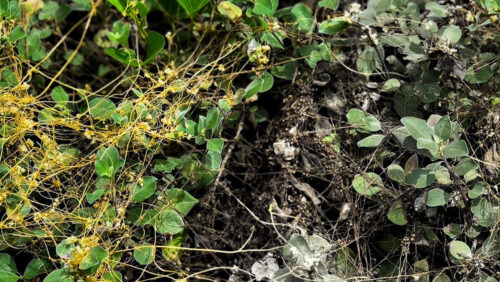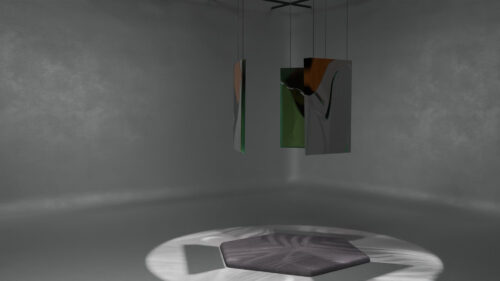Anthropogenic Encroachment aims to provoke critical reflection on humanity’s dual roles both as intruder and collaborator within post-natural ecosystems. As Bernard Stiegler noted, we live in a complex epiphylogenetic era. Those of us residing in the Anthropocene epoch find ourselves subsumed by the proliferation of technology. Artifacts of material culture we implement manifest diversely throughout our world, gradually reshaping our behavior, perception and understanding.
By reconceptualizing humans as an invasive species within this ecosystem, the exhibition’s narrative prompts alteration of participants as intruders into our space. Inspired by Dogville, five new works will be situated in a theatrical-conceptual space. Beggar imagines the speculative alteration of Dodder’s genome for human genetic integration, enabling a direct way for humans to parasite and consume nutrients from plants. Vibration and Traces focuses on the destructive impact on the environment when minor human acts are aggregated. Words Nowhere to Go criticizes constraints on the free speech/expression endemic of internet culture, aiming to reconnect our utterances with environment and people. Solitude Internet reexamines how technology may re-embrace our essential nature. At the Bend of the Street denotes today’s human rights/privacy predicament, employing city maps/private hotspots to symbolize individuals’ yearning for liberty and sanctuary amidst pervasive surveillance. These works immerse viewers, provoking thoughts and discourses.
-

At the Bend of the Street
Yu-Ching Lin (TW)
Representing an oasis filled with freedom. Here we find that technology has gradually stripped away human rights, confining humanity to a cage devoid of privacy, surrounded by invisible jailers and watched by billions of eyes.
-

Beggar
Yi-Jie WU (TW), Ying-Ying CHIU (TW)
Dodder, a plant that thrives in Taiwan, was first documented in Shennong Bencaojing. Dodder cannot photosynthesize or absorb water from the soil. To survive, it parasitizes other plants, using unique suction structures to penetrate the host to gain nutrients, causing the plant to wither.
-

Solitude Internet
Wei San Chiang (TW), Yi Yen Chen (TW)
As humans began using tools, technology expanded our individual boundaries, yet our consciousness remains confined within our bodies, highlighting loneliness.
-

Vibration and Traces
Chi-Hung Huang (TW)
The artificial earthquake refers to seismic events caused by human activities rather than natural occurrences. As the human population increases, unintentional artificial earthquakes also begin to be created, with even the simple act of human movement contributing inadvertently.
-

Words Nowhere to Go
Chun-Huang Lin (TW)
People can encapsulate intimate memories, emotional phrases and posts that had to be removed into barcode stickers, concealing them in the tapestry of everyday life. Through this project, we aim to evade the “textual prison” imposed in the digital age.

National Tsing Hua University, Taiwan (TW)
Established in 1911, National Tsing Hua University (NTHU) was originally located in Beijing, China and known as Tsing Hua Academy. It relocated to Hsinchu, Taiwan in 1956. NTHU has developed into a comprehensive research university offering a full range of degree programs in science, technology, engineering, humanities, social sciences, management, education and arts. NTHU consistently ranks as a premier university in East Asia, and is widely recognized as a leading incubator for future leaders.
Credits
Sponsored by:
College of Arts, National Tsing Hua University (國立臺灣清華大學藝術學院)
Spring Foundation (春之文化基金會)
Graduate Institute of Art and Technology, National Tsing Hua University (國立清華大學藝術學院科技藝術研究所)
Interdisciplinary Program of Technology and Art, National Tsing Hua University (國立清華大學藝術學院學士班)





